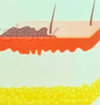Primer semestre: Primer Bloque: clase 25 de febrero Flashcards
How many measurements are needed in the home blood pressure measurement?
4 per day, 2 in the morning and 2 in the evening, once before Tx and once after Tx
Where is ambulatory BP measurement used?
In clinics and researches
What are the advantages and disadvantages of ambulatory BP measurements?
Advantages: provides a 24/7 BP measurement
Disadvantages: it’s expensive
How to diagnose hypertension?
With 2 separate occasional measurements over 140/90 mmHg
How many minutes do we have to wait to measure BP if the Px has recently drunk coffee or exercised?
30 minutes
What is HTN?
Hypertension
What are the 3 types of hypertension?
Whitecoat
Masked
Nocturnal
What causes the whitecoat HTN?
An anxiety response from the Px when he’s in a clinical context
What are the values of whitecoat HTN?
Over 140/90mmHg in medical settings
What causes masked hypertension?
When the Px cheats on his/her treatment and takes the Tx only when he’s about to visit the Doctor
What are the values for masked BP?
Office BP <140/90 but increased to >135/85 at home
What is the risk for the Px with masked BP to develop a cardiovascular disease?
Up to 10 to 30%
What is nocturnal HTN?
When there is a BP dipping at night
How can we detect nocturnal HTN?
Only with an ambulatory BP monitoring
What are SBP and DBP?
Systolic BP and dyastolic BP
What is the normal range for SBP?
<120mmHg
What is the normal range for DBP?
<80mmHg
What is the prehypertension range for SBP?
120-139mmHg
What is the prehypertension range for DBP?
80-89mmHg
What is the stage 1 hypertension range for SBP?
140-159mmHg
What is the stage 1 hypertension range for DBP?
90-99mmHg
What is the stage 2 hypertension range for SBP?
>160mmHg
What is the stage 2 hypertension range for DBP?
>100mmHg
What is orthostatic hypotension?
The 20mmHg drop in SBP and 10mmHg drop









